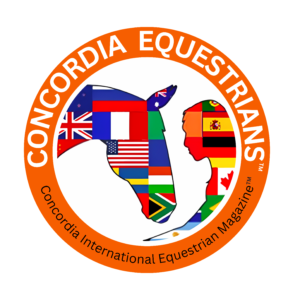THE MANDATORY USE OF DOUBLE BRIDLES IN DRESSAGE
As the Fédération Equestre Internationale (FEI) continues to rule that the double bridle be compulsory in Grand Prix Competitions – Susan Gordon, co-author of the Compassionate Equestrian gives us her opinion.
This article is published in Issue 7 of the CONCORDIA INTERNATIONAL EQUESTRIAN MAGAZINE – the current issue and archived issues are free to download and read online.

As conscious, compassionate equestrians, we have to consider that every piece of equipment we place on a horse has the potential to cause discomfort and pain. From an unnoticed wrinkle in a saddle blanket, a boot or bandage that’s too tight, a cranked-down noseband, or an inappropriate bit, it is only through mindful attention to a horse’s non-verbal responses that we can determine the potential trigger of poor behaviours and regression in training. Think about how you feel with something as seemingly benign as a small paper cut, a blister on your heel from an ill-fitting shoe, or a toothache. Does the pain make you reactive or affect your mood? How do you convey to others that you are hurting?
Every step we ask the horse to take creates a window of potential discomfort, injury, and pain. If we are incredibly fortunate, we can progress a horse through various levels of a chosen discipline without issue, but this is rare in my experience. If one’s focus is solely on Grand Prix, for example, but the horse is simply unsuitable for the task or is injured along the way, pushed too quickly, and not allowed enough recovery time, that is not a conscientious approach to the horse’s welfare. Horsemanship requires an honest evaluation and constant re-evaluation of ability, willingness, and soundness and how well the horse suits the skill and temperament of the rider. Only some horses destined for high performance can reach that level, and many horses should be moved to an entirely different discipline or not be ridden at all.
I fully support the option of riding and showing at upper levels without a double bridle and spurs. A sound horse, correctly trained in the Classical Method, should be just as responsive in a snaffle (metal or rubber) and demonstrate collection without spurs or a curb rein. If not allowed as an option, a show could add a separate GP class for those who would like to show at this level with less-aversive gear. In this situation, the difference between a horse pulled into a frame and one schooled forward and balanced would be very clear. If judged accurately and honestly, we would demonstrate to the public and other horsemen how dressage truly means “training.”
I have ridden in almost every type of headstall and bit, including Western low-port curbs, snaffles with and without a noseband, a double bridle, pelham, Kimberwicke, side-pull, and bosal hackamore. Of these, my favourite is still the bosal. While it is a “no bit” option, the bosal does not sit tightly around the nose and requires fine use and control of the hands.
I hope we can move forward on welfare, training, and tack in the near future as more research and commendable efforts on behalf of elite riders and trainers continue to help make the world a better place for horses.
This article is published in Issue 7 of the CONCORDIA INTERNATIONAL EQUESTRIAN MAGAZINE – the current issue and archived issues are free to download and read online.
